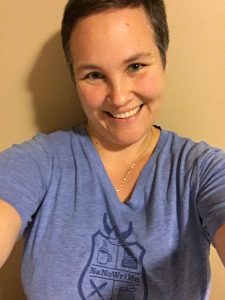
6th grade gifted writer, Sydney, working on the next great American novel
NaNoWriMo is coming!
National Novel Writing Month happens every November and is something you should bring into your classroom to encourage community, creativity, perseverance, and independence in the writing lives of your students.
NaNoWriMo asks you to write a novel in one month. It seems insane and impossible, but over 300,000 people do it yearly. If you have never participated, you should try it out this year. And if you have a classroom of students, you should use NaNoWriMo’s Young Writer’s Program to help your students engage in this experience.
I made participating in NaNoWriMo an option in my 8th grade classroom. The camps of students who usually participated included: serious gifted writers, everyday kids looking to be challenged, and special education students.
The Young Writer’s Program has lots of tools and resources to help you give your student writers all the support they need. This includes novel-writing workbooks, lesson plans, charts, buttons, and swag. Not to mention an awesome online community of student writers and mentor authors who give great pep talks.
Quantity Leads to Quality
The whole idea behind NaNoWriMo is just to get your story written. Don’t worry if it makes sense, or if you spelled a word wrong, or if your characters are flat. (Editing comes in later months, for those of you grammar sticklers who were wondering.) Just get your story out there and quit making excuses!
Now, some would argue that writing every day is crazy business! And, having participated in NaNoWriMo, I know that it really is rather hard to write every day, on top of all the other things going on in your teaching and personal life. But, because you have committed to doing this, and because you have a community of other crazy writers on your side, something makes you keep going.

Students in the media center at Oakview Middle School, updating their novel progress on the school-wide chart.
Community of Writers
When you commit to joining NaNoWriMo with your students, you are really creating a community of writers. I had a wide range of student writers participate. The special education students had IEP goals in writing and spelling, but they saw themselves as writers and would come with notebooks full of the stories they had started. These were stories that paralleled video game plots or stories they knew from movies, which they claimed as their own and added new twists and turns to. The gifted writers came to try out new genres and forms of storytelling, and to work on stories they had started on Wattpad.
Some years I started an after-school club for NaNoWriMo. This was nice because I could offer it to different grades and was able to get the other ELA teachers in my school involved. Many of them would come to one of the after-school meetings to see their students write and share in the fun. I even convinced our singing-science teacher to create a NaNoWriMo commercial one year.
The NaNoWriMo website also has an online community that students enjoyed participating in. You can friend people if you know their username, you can send encouraging messages to users, or you can post in the private forums to ask for advice or get feedback on sections of your novel.
Sense of Accomplishment
Most of my students who participated met or exceeded their word-count goals. Yet one of the first things we talked about as a group was setting realistic, attainable goals. We used charts and stickers to mark our progress, and our community was really supportive of each other.
We enjoyed the challenge of meeting our daily word-count goals. But another benefit of NaNoWriMo is that students who meet their word-count goal can submit their novel and get a published copy of their writing. This is a highly motivating factor for most students.
I have attempted to write a novel in NaNoWriMo every year since 2010 and I have never won (it all usually unravels for me around Thanksgiving). But I’m still planning on doing it again this year. If you want to do it, but don’t think you can manage during the school year, you should consider Camp NaNoWriMo–where you can pick any month (think summer!) and work on a month-long writing project. And if you like to compose with digital writing and mixed media, check out DiGiWriMo.
Regardless of whether you try it out, you should definitely bring it up to your students as something they might want to try. You might be surprised to find how many aspiring, excited writers you have in your class.
 Caroline Thompson (@TeacherThompson) taught middle school ELA for twelve years in Lake Orion before becoming a stay-at-home mom. She supports AARI teachers for Oakland Schools as an independent literacy consultant in the areas of digital media, professional development, and non-fiction resources. Caroline is a Reading and Writing Workshop advocate, a 2008 Oakland Writing Project Teacher Consultant, and a 2009 Oakland County Outstanding Teacher of the Year Nominee. She has a BA in English from Michigan State University and a Masters in the Art of Teaching Reading from Oakland University. She lives in Berkley, Michigan with her husband and their three year old daughter.
Caroline Thompson (@TeacherThompson) taught middle school ELA for twelve years in Lake Orion before becoming a stay-at-home mom. She supports AARI teachers for Oakland Schools as an independent literacy consultant in the areas of digital media, professional development, and non-fiction resources. Caroline is a Reading and Writing Workshop advocate, a 2008 Oakland Writing Project Teacher Consultant, and a 2009 Oakland County Outstanding Teacher of the Year Nominee. She has a BA in English from Michigan State University and a Masters in the Art of Teaching Reading from Oakland University. She lives in Berkley, Michigan with her husband and their three year old daughter.
